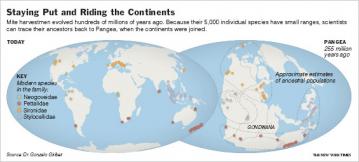The vision of biogeography in Explore Evolution is shockingly narrow. The examples of biogeography discussed are: the Gal Islands, the Hawaiian Islands, and island continents Australia and ancient South America. The discussion of marsupial biogeography across South America and Australia bizarrely omits any discussion of plate tectonics, a central theme in any discussion of biogeography over long time scales. No discussion at all is offered of many crucial biogeographic concepts that bear on evolutionary biology.
Biogeography generally focuses on finding repeated geographical patterns across multiple taxonomic groups. For instance, in the 1850s, Alfred Russel Wallace (who independently discovered natural selection) found in his travels through the East Indies that there was a sharp line between the species found in Southeast Asia and the islands as far east as Borneo and Bali, while islands only a few miles away had communities of species with closer affinities to the Australian fauna. The same pattern could be found in a range of groups, including mammals and birds, indicating that some common process acted to allow diversification of groups within regions. He summarized the significance of this result by stating "Every species has come into existence coincident both in space and time with a closely allied species" (Wallace, 1855, "On the Law Which Has Regulated the Introduction of New Species," Annals and Magazine of Natural History 16:184-196.)
By comparing macroevolutionary patterns between different groups, we find that the same patterns repeat. This strongly suggests that the same forces drove the diversification of those different groups. This also makes it possible to compare rates of evolution of those groups. For instance, a recent study of the global biogeography of mites allows unique insights into the processes driving diversity within and across various groups of mammals.
 Mite Biogeography: Modern and historical locations of mites. Because these species do not move long distances, the current locations of species change principally because of continental drift, not because of migration. "By studying a group of organisms with not only an ancient origin, low vagility and restricted habitats but also a present global distribution, we have been able to test biogeographical hypotheses at a scale rarely attempted." Sarah L. Boyer, Ronald M. Clouse, Ligia R. Benavides, P. Sharma, Peter J. Schwendinger, I. Karunarathna, G. Giribet (2007) "Biogeography of the world: a case study from cyphophthalmid Opiliones, a globally distributed group of arachnids," Journal of Biogeography (OnlineEarly Articles). Figure from Carl Zimmer (2007) "A Daddy Longlegs Tells the Story of the Continents Big Shifts," The New York Times, 8/28/2007.
Mite Biogeography: Modern and historical locations of mites. Because these species do not move long distances, the current locations of species change principally because of continental drift, not because of migration. "By studying a group of organisms with not only an ancient origin, low vagility and restricted habitats but also a present global distribution, we have been able to test biogeographical hypotheses at a scale rarely attempted." Sarah L. Boyer, Ronald M. Clouse, Ligia R. Benavides, P. Sharma, Peter J. Schwendinger, I. Karunarathna, G. Giribet (2007) "Biogeography of the world: a case study from cyphophthalmid Opiliones, a globally distributed group of arachnids," Journal of Biogeography (OnlineEarly Articles). Figure from Carl Zimmer (2007) "A Daddy Longlegs Tells the Story of the Continents Big Shifts," The New York Times, 8/28/2007. The authors of the mite research explain that "To date, few conclusive empirical studies of the worldwide historical biogeography of terrestrial organisms are available, because the members of clades [groups containing all descendants of a single common ancestor] with global distributions tend to present dispersal abilities that obscure historical biogeographical patterns. To find a group of land organisms with an ancient global distribution, and therefore suitable for a study of historical biogeography on a global scale, one needs to look among the earliest colonizers of terrestrial environments" (Boyer, et al. 2007, "Biogeography of the world: a case study from cyphophthalmid Opiliones, a globally distributed group of arachnids," Journal of Biogeography, OnlineEarly Articles).
These data establish a context within which other groups' diversity can be examined. While the mites those researchers were studying have a long history, and can be traced back nearly to the beginning of life on land, other groups evolved much later, and exist only in the subset of the world that was connected at the time they evolved. Not only is biogeography evidence against the fixity of species, it is evidence against the fixity of larger taxonomic categories, since groups of much different taxonomic rank follow the same biogeographic patterns. Marsupial biogeography, discussed below, fits well with part of the pattern seen in the mites. The biogeography of extant mammals matches a large portion of the mite data, and the inclusion of fossilized mammalian ancestors results in a biogeography that matches yet more of the mite data. This biogeographic pattern can not be explained without reference to common descent.
Explore Evolution does not even mention major areas of biogeographic research such as gradients in species diversity found as one travels from the poles to the equator, or from sea level to the tops of mountains. Such studies are central to our understanding of the origins not just of individual species, but the evolutionary processes which generate species diversity, and the book's silence on these topics does students a disservice.
